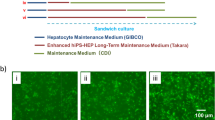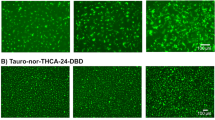Abstract
The development of models for predicting hepatotoxicity is warranted, as the hepatotoxicity risk of 38–51% of compounds is undetectable in nonclinical studies. Cholestatic drug-induced liver injury (DILI) is a condition in which bile acids are abnormally excreted into the capillary bile canaliculi and are accumulated in hepatocytes, caused by the inhibition of bile salt export pump (BSEP), a transporter that is mainly associated with excretion of bile acids. Although laboratory animals are used as models, the use of human-derived cells is required owing to species differences. Unfortunately, primary human hepatocytes (PHHs) show rapid loss of function in culture and difficulties in forming bile canaliculi. Therefore, we aimed to develop an in vitro culture method for the efficient formation of bile canaliculi and for assessing the function of BSEP in PHHs. Here, PHHs were cultured from 1 h after thawing to day 2 with Z-VAD-FMK, a total caspase inhibitor, and RevitaCell™ supplement, an irreversible Rho-associated coiled-coil forming kinase (ROCK) inhibitor, in combination with RM-101. The PHHs formed bile canaliculi and showed BSEP function on day 6 of culture. Our findings suggest that cultured PHHs may improve the prediction accuracy of the risks of cholestatic DILI-contained toxicity on bile canaliculi.






Similar content being viewed by others
References
Ananthanarayanan M, Balasubramanian N, Makishima M, Mangelsdorf DJ, Suchy FJ (2001) Human bile salt export pump promoter is transactivated by the farnesoid X receptor/bile acid receptor. J Biol Chem 276:28857–28865
Bachour-El Azzi P, Sharanek A, Burban A, Li R, Guével RL, Abdel-Razzak Z, Stieger B, Guguen-Guillouzo C, Guillouzo A (2015) Comparative localization and functional activity of the main hepatobiliary transporters in HepaRG cells and primary human hepatocytes. Toxicol Sci 145:157–168
Boaglio AC, Zucchetti AE, Sánchez Pozzi EJ, Pellegrino JM, Ochoa JE, Mottino AD, Vore M, Crocenzi FA, Roma MG (2010) Phosphoinositide 3-kinase/protein kinase B signaling pathway is involved in estradiol 17β-D-glucuronide-induced cholestasis: complementarity with classical protein kinase C. Hepatology 52:1465–1476
Chiang JY (2009) Bile acids: regulation of synthesis. J Lipid Res 50:1955–1966
Crocenzi FA, Mottino AD, Roma MG (2004) Regulation of synthesis and trafficking of canalicular transporters and its alteration in acquired hepatocellular cholestasis. Experimental therapeutic strategies for its prevention. Curr Med Chem 11:501–524
Hendriks DF, Fredriksson Puigvert L, Messner S, Mortiz W, Ingelman-Sundberg M (2016) Hepatic 3D spheroid models for the detection and study of compounds with cholestatic liability. Sci Rep 6:35434
Julian L, Olson MF (2014) Rho-associated coiled-coil containing kinases (ROCK): structure, regulation, and functions. Small GTPases 5:e29846
Kis E, Ioja E, Nagy T, Szente L, Herédi-Szabó K, Krajcsi P (2009) Effect of membrane cholesterol on BSEP/Bsep activity: species specificity studies for substrates and inhibitors. Drug Metab Dispos 37:1878–1886
Koyama S, Arakawa H, Itoh M, Masuda N, Yano K, Kojima H, Ogihara T (2018) Evaluation of the metabolic capability of primary human hepatocytes in three-dimensional cultures on microstructural plates. Biopharm Drug Dispos 39:187–195
Oizumi K, Sekine S, Fukagai M, Susukida T, Ito K (2017) Identification of bile acids responsible for inhibiting the bile salt export pump, leading to bile acid accumulation and cell toxicity in rat hepatocytes. J Pharm Sci 106:2412–2419
Ölander M, Wiśniewski JR, Flörkemeier I, Handin N, Urdzik J, Artursson P (2019) A simple approach for restoration of differentiation and function in cryopreserved human hepatocytes. Arch Toxicol 93:819–829
Onakpoya IJ, Heneghan CJ, Aronson JK (2016) Post-marketing withdrawal of 462 medicinal products because of adverse drug reactions: a systematic review of the world literature. BMC Med 14:10
Pan G, Boiselle C, Wang J (2012) Assessment of biliary clearance in early drug discovery using sandwich-cultured hepatocyte model. J Pharm Sci 101:1898–1908
Pound P, Ritskes-Hoitinga M (2018) Is it possible to overcome issues of external validity in preclinical animal research? Why most animal models are bound to fail. J Transl Med 16:304
Qu X, Zhang Y, Zhang S, Zhai J, Gao H, Tao L, Song Y (2018) Dysregulation of BSEP and MRP2 may play an important role in isoniazid-induced liver injury via the SIRT1/FXR pathway in rats and HepG2 cells. Biol Pharm Bull 41:1211–1218
Sakai Y, Okumura H, Iwao T, Watashi K, Ito K, Matsunaga T (2019) Development of an in vitro cholestatic drug-induced liver injury evaluation system using HepG2-hNTCP-C4 cells in sandwich configuration. Toxicol in Vitro 61:104619
Schuster D, Laggner C, Langer T (2005) Why drugs fail–a study on side effects in new chemical entities. Curr Pharm Des 11:3545–3559
Sebbagh M, Renvoizé C, Hamelin J, Riché N, Bertoglio J, Bréard J (2001) Caspase-3-mediated cleavage of ROCK I induces MLC phosphorylation and apoptotic membrane blebbing. Nat Cell Biol 3:346–352
Susukida T, Sekine S, Nozaki M, Tokizono M, Ito K (2015) Prediction of the clinical risk of drug-induced cholestatic liver injury using an in vitro sandwich cultured hepatocyte assay. Drug Metab Dispos 43:1760–1768
Swift B, Brouwer KL (2010) Influence of seeding density and extracellular matrix on bile acid transport and mrp4 expression in sandwich-cultured mouse hepatocytes. Mol Pharm 7:491–500
Swift B, Pfeifer ND, Brouwer KL (2010) Sandwich-cultured hepatocytes: an in vitro model to evaluate hepatobiliary transporter-based drug interactions and hepatotoxicity. Drug Metab Rev 42:446–471
Wang L, Prasad B, Salphati L, Chu X, Gupta A, Hop CE, Evers R, Unadkat JD (2015) Interspecies variability in expression of hepatobiliary transporters across human, dog, monkey, and rat as determined by quantitative proteomics. Drug Metab Dispos 43:367–374
Yamasaki C, Ishida Y, Yanagi A, Yoshizane Y, Kojima Y, Ogawa Y, Kageyama Y, Iwasaki Y, Ishida S, Chayama K, Tateno C (2020) Culture density contributes to hepatic functions of fresh human hepatocytes isolated from chimeric mice with humanized livers: novel, long-term, functional two-dimensional in vitro tool for developing new drugs. PLoS ONE 15:e0237809
Ye H, Wang Q (2018) Efficient generation of non-integration and feeder-free induced pluripotent stem cells from human peripheral blood cells by Sendai virus. Cell Physiol Biochem 50:1318–1331
Zollner G, Fickert P, Zenz R, Fuchsbichler A, Stumptner C, Kenner L, Ferenci P, Stauber RE, Krejs GJ, Denk H, Zatloukal K, Trauner M (2001) Hepatobiliary transporter expression in percutaneous liver biopsies of patients with cholestatic liver diseases. Hepatology 33:633–646
Acknowledgements
The authors thank Dr. Kousei Ito and Dr. Akinori Takemura (Chiba University, Japan) for providing the anti-BSEP polyclonal antibody.
Funding
This work was partly supported by Grants-in-Aid from the Japan Society for the Promotion of Science (Grants 20K16051 and 22K06773). Furthermore, support was also provided by the Research on Development of New Drugs from Japan Agency for Medical Research and Development (Grants 19be0304203h0003 and 20be0304203h0004).
Author information
Authors and Affiliations
Corresponding author
Ethics declarations
Conflict of interest
The authors declare no competing interests.
Additional information
Masanari Matsumura is a co-first author.
Supplementary Information
Below is the link to the electronic supplementary material.
Rights and permissions
Springer Nature or its licensor (e.g. a society or other partner) holds exclusive rights to this article under a publishing agreement with the author(s) or other rightsholder(s); author self-archiving of the accepted manuscript version of this article is solely governed by the terms of such publishing agreement and applicable law.
About this article
Cite this article
Sakai, Y., Matsumura, M., Iwao, T. et al. Culture methods focusing on bile canalicular formation using primary human hepatocytes in a short time. In Vitro Cell.Dev.Biol.-Animal 59, 606–614 (2023). https://doi.org/10.1007/s11626-023-00805-y
Received:
Accepted:
Published:
Issue Date:
DOI: https://doi.org/10.1007/s11626-023-00805-y




